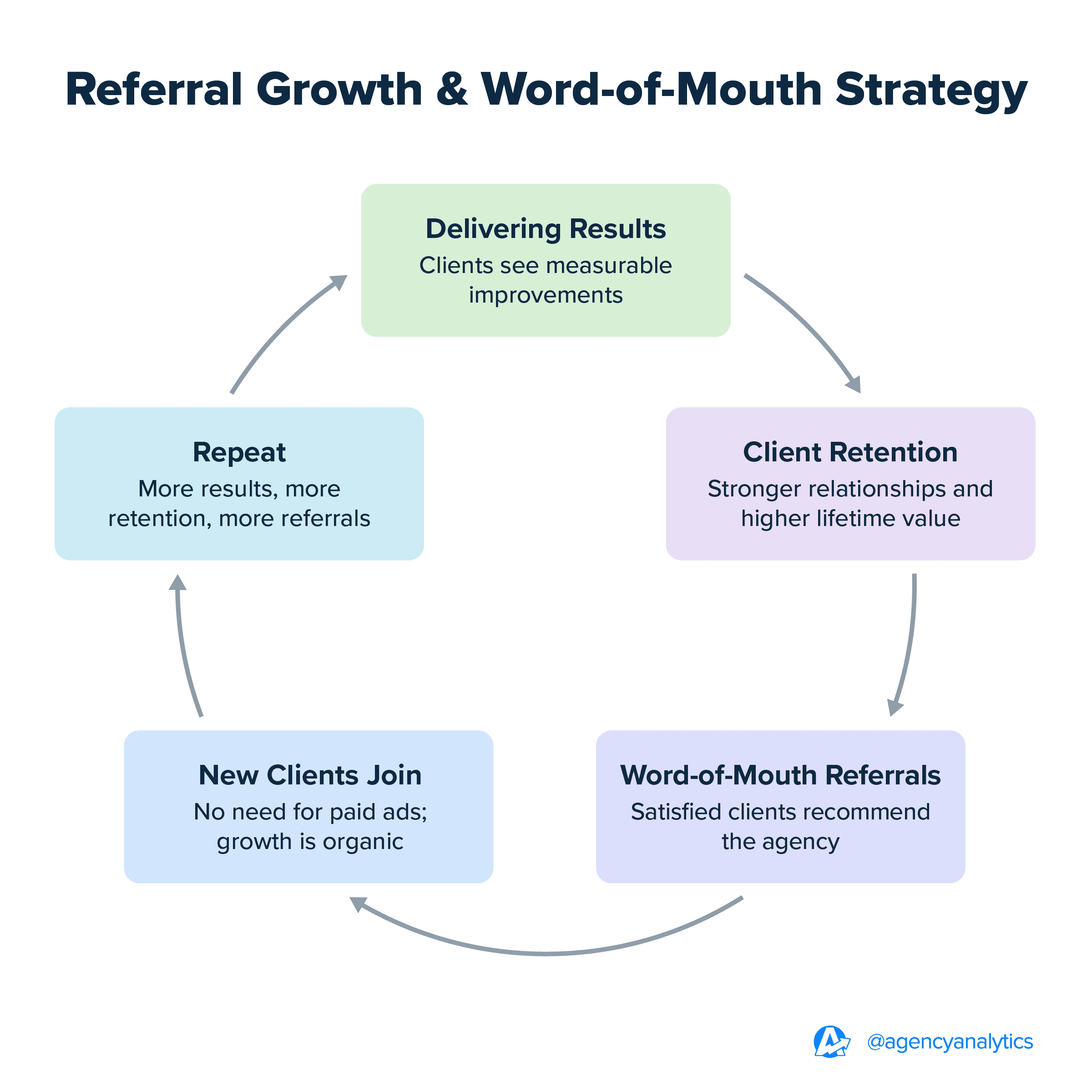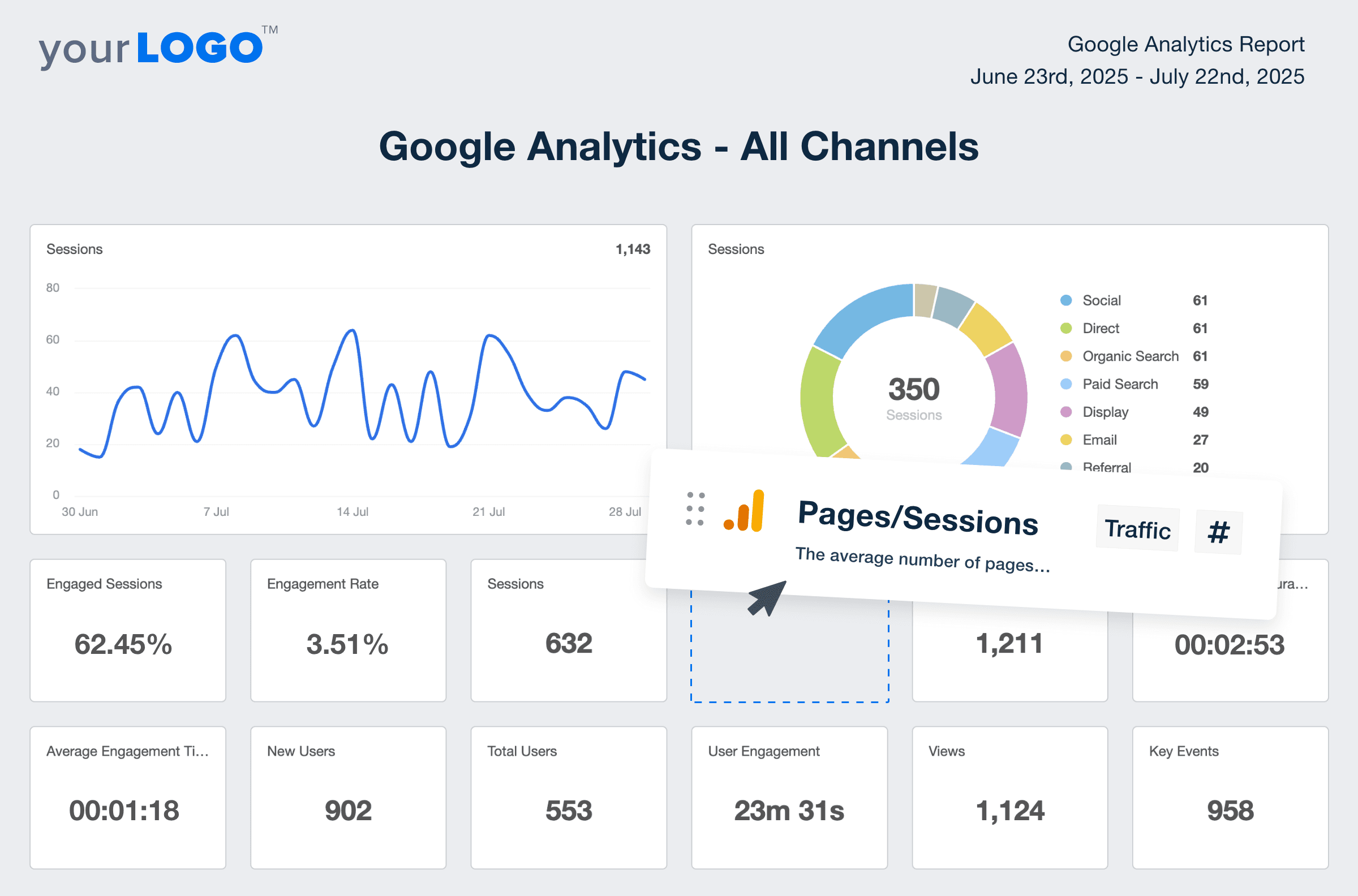Table of Contents
Table of Contents
- From Student TV to Digital Marketing Pioneer
- Selling Links Expands To Building a Custom CMS
- The Hard Truth: Letting Go of Proprietary Software
- The Business Model That Changed Everything
- The Secret to Scaling Without Advertising
- The Role of Automated Reporting in Scaling Digital Stream
- Scaling an Agency Smarter, Not Harder
- To Win the Agency Game, Never Stop Evolving
7,000+ agencies have ditched manual reports. You can too.
Free 14-Day TrialQUICK SUMMARY:
Digital Stream bet big on custom software—until they realized it was holding them back. Faced with a tough decision, they pivoted fast, shifting focus to what truly drives agency growth. Discover how they built a thriving, scalable business by letting go of the wrong priorities and doubling down on what works.
By mid-2016, Russell Brown had a tough choice to make.
For over a decade, his agency, Digital Stream, had been building and refining its own custom content management system (CMS). The team believed proprietary software would give them an edge over competitors, and they had poured countless hours and significant capital into its development.
“We spent so much time and effort on developing our own software. And it was really good,” Russell recalls.
But just as they were about to launch the latest version, Elementor hit the market—a game-changing website builder that made their years of custom development obsolete.
Digital Stream’s CMS was at risk of becoming a sunk cost with no return.
Russell faced a crossroads:
Keep pushing forward with their in-house CMS, hoping it could still compete.
Cut their losses and pivot to industry-standard platforms like WordPress and Shopify.
It was a painful but necessary decision—and the smartest call Russell ever made.
“That would have sent us out of business if we continued down that track,” he admits. “We just couldn’t compete with the size of these much bigger companies overseas.”
By letting go of custom software development, Digital Stream freed up time, resources, and focus, allowing it to shift toward scalable, results-driven digital marketing services.
That decision set Digital Stream on a new trajectory, transforming it from a small web development shop into a thriving digital marketing agency serving nearly 200 clients.
Name | Agency | Agency Stats | Location |
|---|---|---|---|
Russell Brown | Digital Stream | 14 employees
200 clients
Est. 1999 | Hamilton, NZ |
From Student TV to Digital Marketing Pioneer
Before Russell Brown became the founder of one of New Zealand’s longest-running digital agencies, he was just a young entrepreneur with a passion for media and a knack for spotting opportunities.
In the late 1990s, Russell was deeply involved in video production and student television, producing promotional videos and running a student TV station. But everything changed when he stumbled upon the internet, a new frontier still in its infancy.
“I saw the power of the internet back then,” he says. “Even in those days, there was video online. But what really stood out was that our city, Hamilton, didn’t even have a website.”
So, in 1999, Russell took matters into his own hands. He purchased the domain HamiltonCity.co.nz and pitched the idea of an official city website to the local council.
“They told me, ‘That’s a great idea, but we just had our budget cut by a million bucks. Why don’t you do it?’”
That unexpected challenge set Russell’s entrepreneurial journey in motion. He enrolled in a six-week "Be Your Own Boss" program, which helped him draft his first-ever business plan.
Armed with $5,000 in startup assistance and a small safety net from unemployment benefits, he teamed up with a friend—a technical coder—and built Hamilton’s website using Microsoft FrontPage.
Selling Links Expands To Building a Custom CMS
This was before Google's dominance, and businesses were just starting to realize they needed an online presence. Russell’s first revenue stream was selling links and one-page websites to local businesses.
“We were selling links to people who had a website, or we’d create one-page websites for businesses that didn’t have one,” he explains. “This was still early days—most businesses weren’t even online yet.”
That early hustle set the foundation for Digital Stream, and over time, clients began asking for more than just links. They wanted full websites—and they wanted to manage them themselves.
This led to the next big step: Building an in-house CMS. At the time, most businesses still relied on developers for updates. But with their own CMS, Digital Stream was able to empower clients to make self-serve adjustments on custom-built websites.
This offering gave the agency a leg up on competitors. Clients loved the flexibility their CMS offered, and business was booming. But, big changes in the road ahead would soon create a significant challenge.
Digital Stream’s custom CMS was built with .NET, Microsoft’s primary framework for building web applications. It was widely used for enterprise software and offered strong security and stability. However, it was also complex, costly, and required specialized developers.
Technology was evolving fast. The rise of more flexible, user-friendly website platforms like WordPress began to impede the success of the agency’s custom solution.
Russell, always eager to stay ahead of the curve, traveled to the U.S. to learn about the latest trends in marketing and automation. Russell took note of emerging marketing automation tools like ClickFunnels, which reinforced the shift toward scalable, user-friendly solutions.
Determined to keep Digital Stream at the forefront, the agency spent three to four years upgrading its CMS to match the ease of use of these new platforms.
But then, everything changed.
The Hard Truth: Letting Go of Proprietary Software
As they neared the launch of their upgraded CMS, Elementor hit the market—a game-changing WordPress page builder that made web design accessible to everyone.
Digital Stream had a choice:
Push forward with its own CMS despite increasing competition and high development costs.
Make the drastic shift to abandon its proprietary system and go all-in on platforms like WordPress and Shopify.
“Making the switch to PHP and WordPress was a big ask for our staff, who had years of experience in .NET,” Russell says.
But the numbers didn’t lie. Custom software development was no longer a viable path.
We had our own CMS for a good 15, 16 years. We had invested so much time and money, but we knew if we didn’t change, we’d go out of business.
Russell Brown, Founder, Digital Stream
Custom CMS | Third-Party Platforms |
|---|---|
High maintenance costs Slow updates Scalability issues Internal resource strain | Lower costs Regular updates Flexible integrations Focus on client results |
So, Digital Stream made the painful yet necessary decision to scrap their CMS.
Russell called a team meeting: “I told them, ‘This is where we’re at. This is what we need to do. Are you in?’”
Every single team member said yes.
The transition was tough, but ultimately, it allowed Digital Stream to focus on what truly mattered: delivering results, not maintaining software.
And with that shift, the agency’s identity started to change.
The Business Model That Changed Everything
By late 2016, Digital Stream had fully pivoted away from their custom CMS. Website projects and one-time SEO optimization kept the business moving, but Russell saw a critical gap in the agency’s revenue model—and a massive opportunity to scale.
For years, Digital Stream relied on a project-based revenue model. Clients hired the agency for website builds, initial SEO setups, or Google Ads campaigns, but once the work was done, there was no guarantee of continued income.
That uncertainty made it hard to plan for growth, hire strategically, or invest in long-term improvements.
Then, Russell made the key decision to shift the agency’s focus toward monthly retainers.
“We really decided to double down on that model,” he says. “It was a game-changer for us.”
Instead of delivering services as one-time projects, Digital Stream started offering ongoing digital marketing packages, including:
Local and national SEO (website optimization, Google Business Profile, link-building)
Google Ads management
Facebook and Instagram advertising
Email marketing and conversion optimization
The impact was immediate.
Today, around 60 of Digital Stream’s 200 clients are on monthly retainers—bringing in predictable, recurring revenue that allows the agency to scale sustainably.
“It’s really changed the model for us,” Russell explains. “We don’t want set-and-forget-it clients. We don’t want clients that tick the box—‘Hey, I’ve got a website, and that’s it.’”
By focusing on ongoing strategy and optimization rather than one-off projects, Digital Stream ensured that its clients saw continuous improvements in their digital marketing results. As those results improved, clients were more likely to stay and spend more over time.
The SEO Breakthrough That Fueled Growth
One of the biggest turning points came when Digital Stream expanded its SEO offerings beyond basic website optimization.
“We had always gotten good SEO results just from building sites,” Russell says. “But back then, it was just a one-time optimization. Those days are well and truly gone.”
The agency unlocked a powerful driver of long-term client retention by developing robust SEO strategies—including local SEO (map listings, citations, Google Business Profile optimizations) and full-scale website SEO.
“And that’s the great thing,” Russell explains. “We’ve seen what we can do for them and the results that they’re getting,”
With clients seeing real, measurable growth, referrals started pouring in. And that led to an even bigger realization: They didn’t need to advertise their services.
“We stopped our digital marketing—our own advertising—and we haven’t had to bring it back since,” Russell says. “It’s all existing clients and word-of-mouth referrals.”
With a business built on results, reputation, and relationships, Digital Stream didn’t need to chase new leads through paid ads. Instead, happy clients became their biggest growth engine.
But maintaining those relationships meant delivering clear, professional reporting—without wasting billable hours.
The Secret to Scaling Without Advertising
For most digital agencies, client acquisition is a constant battle. Running ads, cold outreach, and sales funnels are standard tactics to keep the pipeline full.
But Digital Stream took a different approach—one that eliminated the need for paid marketing entirely.
The agency’s growth strategy was simple: Deliver results so good that clients couldn’t help but spread the word.
Russell and his team focused on:
SEO and PPC strategies that drove measurable ROI.
Ongoing client support and strategy meetings to maintain engagement.
Providing a full-service digital growth plan, not just a website or campaign.
With a solid roster of retainer clients and a track record of success, Digital Stream didn’t need to chase leads—clients came to them.
Our existing customers are increasing their services with us, spending more money, and they’re also referring us because of the results they’re getting.
Russell Brown, Founder, Digital Stream

Facebook Groups: The Hidden Agency Network
While referrals fueled new business, industry networking played a major role in keeping Digital Stream ahead of the curve.
Russell is deeply engaged in digital marketing Facebook groups, where agency owners share insights, software recommendations, and strategies.
“I’m in so many Facebook groups,” he says. “It’s where I learn about new tools, see what’s working for other agencies, and stay on top of trends.”
This tight-knit online community is how Russell first discovered AgencyAnalytics—a tool that would help Digital Stream level up its client reporting and free up hours of manual work.
“People are constantly asking, ‘What are you using for reporting?’ And all the time, AgencyAnalytics kept coming up as highly recommended,” Russell recalls.
At the time, his team was manually putting together reports. It was slow, inefficient, and far from scalable.
So Digital Stream made another big move: Automating reporting to reclaim time and improve client retention.
The Role of Automated Reporting in Scaling Digital Stream
By 2023, Digital Stream had perfected its retainer model. Clients were seeing strong results, referrals were rolling in, and the agency’s revenue was more stable than ever.
But there was still a bottleneck—client reporting.
Russell’s team was losing hours every month manually assembling reports from different platforms:
Google Looker Studio for Google Ads
Oviond for social media marketing
SEMrush for SEO analysis
Google Docs for written insights
It was a cumbersome, time-consuming process that pulled team members away from higher-value work like strategy, CRO, and client growth planning.
“We were using multiple systems. SEO reporting was heavily manual, and it just took way too much time,” Russell explains.
So when he kept hearing about AgencyAnalytics in his Facebook groups, he decided to give it a shot.
AgencyAnalytics brought all our reporting together into one beautiful, easy-to-understand report. It has all the integrations we need, and we were able to automate monthly and quarterly reports.
Russel Brown, Founder, Digital Stream
Instead of spending days compiling data, Digital Stream’s team could now:
Send automated reports with accurate, real-time data.
Write insights directly inside AgencyAnalytics, eliminating the need for Google Docs.
Ensure consistency across SEO, PPC, and social media reports—all from a single platform.
And the best part? It made the agency look even more professional.
“We knew this was an area that was growing for us, and we wanted to up our game,” Russell says. “Better reporting means better account management, which improves client retention.”

Stop spending hours on manual reports. Automate your client reporting with a customizable dashboard that delivers real-time insights—accurate, efficient, and hassle-free. Try AgencyAnalytics free for 14 days.
Building Stronger Agency-Client Relationships
With reporting streamlined and automated, Russell’s team suddenly had more time to focus on strategy, training, and onboarding new clients—without hiring extra staff.
“It’s a way better use of our time,” he explains. “Instead of wasting hours on reports, we’re investing in our clients’ success.”
But beyond efficiency, better reporting led to better client relationships.
Clients who once skimmed over their reports were now engaged, asking questions, and eager to optimize further—leading to stronger retention and upsell opportunities.
“Clients are getting more value, they’re more engaged, and our retention levels are higher,” Russell says. “It kind of snowballs from there, which is great.”
With Digital Stream running more efficiently than ever, Russell is looking toward the future. The agency is shifting toward offering full-scale digital growth strategies, ensuring clients don’t just get marketing services—they get a roadmap for long-term success.
Thanks to automation, streamlined processes, and a strong leadership team, Russell is finally able to step back from the day-to-day grind and focus on the next phase of Digital Stream’s growth.
Scaling an Agency Smarter, Not Harder
After 25 years in the industry, Russell Brown has seen every major shift in digital marketing. From the early days of selling website links to today’s complex, multi-channel growth strategies, he’s kept Digital Stream ahead of the curve by embracing change and adapting fast.
But now, the agency is evolving.
Russell isn’t focused on chasing more clients or adding more services just for the sake of expansion. Instead, he’s doubling down on a smarter, more strategic agency model that keeps Digital Stream’s core strengths intact while delivering even more value to long-term clients.
One of the biggest shifts Russell has made in recent years is stepping back from day-to-day execution and focusing on high-level strategy and business development.
“I really enjoy what I do, but I also want to spend more time with my family,” he says.
With two young kids and a newly purchased beach house with a home office overlooking the water, Russell is intentionally designing a work-life balance that allows him to scale Digital Stream—without burning out.
“We’ve got a great team in place, which allows me to focus on working on the business rather than in it,” he explains.
To support that shift, Digital Stream has:
Built a leadership team to oversee web development and digital marketing, freeing Russell to focus on business strategy.
Invested in automation and reporting, including using AgencyAnalytics to streamline client communication and free up time for strategic planning.
Built a culture of continuous learning—Russell still attends overseas conferences and industry workshops to stay ahead of emerging trends.
To Win the Agency Game, Never Stop Evolving
After 25 years in the business, Russell Brown knows one thing for certain: standing still is not an option.
Continually learn. Get help. Running a business can be lonely, but there’s so much knowledge out there. Find mentors, go to conferences, and talk to other agency owners.
Russell Brown, Founder, Digital Stream
The agencies that thrive are the ones that adapt, innovate, and refine their approach—in marketing and how they run their businesses.
Looking back, Russell says the biggest lesson he learned wasn’t about SEO tactics or ad performance—it was about focusing on what truly moves the needle.
“If I could go back, I’d spend 50% less time developing our own software,” he admits. “That was a major distraction. We should have focused on what actually drives growth.”
With Digital Stream running at full speed and a strong team in place, Russell leads his agency with a clear vision, smarter processes, and the freedom to focus on what’s next.
Because in the agency world, the game is always changing, and the winners are those who never stop evolving.

Written by
Francois Marchand brings more than 20 years of experience in marketing, journalism, and content production. His goal is to equip agency leaders with innovative strategies and actionable advice to succeed in digital marketing, SaaS, and ecommerce.
Read more posts by Francois MarchandSee how 7,000+ marketing agencies help clients win
Free 14-day trial. No credit card required.






